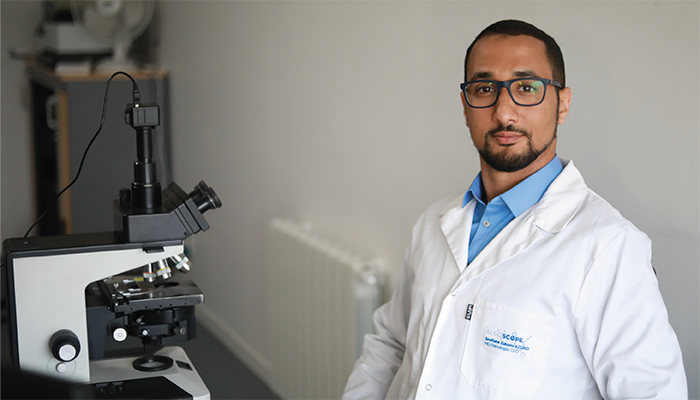
In the fast-paced world of pathology and laboratory medicine, where cutting-edge molecular techniques and digital innovations dominate headlines, it is easy to overlook the foundation of our diagnostic process: pre-analytics. And yet this crucial phase – encompassing specimen handling, labeling, and grossing – remains largely unchanged since the dawn of our specialty. As a pathologist who has witnessed both the marvels of modern diagnostics and the persistent challenges in our workflow, I have a question: Are we neglecting the very cornerstone of our practice?
The stakes in pathology are undeniably high. A single lapse in attention during specimen handling or labeling can lead to sample mix-ups, potentially resulting in misdiagnosis and severe consequences for patient care. Despite this, the medical literature on error rates in pathology remains surprisingly sparse. A systematic review by Raab et al. (2005) found that error rates in anatomic pathology range from 1–43 percent depending on the type of error and detection method (1).
Parts of our workflow – particularly grossing – have remained virtually unchanged for over a century. Our forebears in pathology worked with formalin, alcohol, cutting boards, knives, and rulers. These same tools are still staples in many grossing rooms today. This striking contrast between the advanced end of our process and the relatively outdated beginning is a testament to the need for innovation across the entire pathology workflow.
A personal experience during the development of a prototype clearly highlighted this disparity. When a mechanical engineer asked for a measurement of a component, I instinctively reached for a tape measure. Horrified, he exclaimed, "Are you crazy? That's not precise enough. Use a caliper!" As shame washed over me, I had a sobering thought: "If only he knew what we use to measure tumors – critical measurements that can change TNM staging..." This moment underscored the urgent need for bringing our measurement techniques in line with the precision demanded by modern medicine.
The training process for grossing further illustrates this point. As residents, many of us learned through a time-honored but potentially flawed method: observe, practice under supervision, then dive in solo. This apprenticeship model has its merits, but it may not be sufficient in an era where precision and traceability are paramount.
Moreover, gross examination learning typically occurs in the grossing room itself. Although resources exist in textbooks and videos, accessing this information mid-procedure is challenging. Picture a resident, aproned and gloved, hands deep in a specimen. Their workspace is often limited to a cutting board on a ventilated bench. In this setting, digital resources and AI assistance are conspicuously absent. This harsh reality highlights a critical gap in the specimen's diagnostic journey, where modern technology could potentially offer significant support and guidance.
During my residency, my department head had stuck a quote from an old French pathology textbook above the grossing station: "This is the technical act that demands the most skill, intuition, and general knowledge." This sentiment underscores the complexity and importance of grossing, yet it also highlights how we've perhaps romanticized a process that could benefit from technological advancement.
Yes, we've automated dehydration, staining, and slide mounting processes, and we're beginning to see robotics in microtomy. But compared with the transformations in other areas of healthcare – and in our daily lives, our pre-analytical processes seem stuck in time.
This disparity hit home for me in 2016 when I first used a food delivery app. That same day, a biopsy was misplaced in the lab, causing panic and a work stoppage until it was found. Later that evening, as I received real-time notifications about my pizza's journey across town, the irony struck me: we appear to have better traceability for fast food than for biosamples that can determine a patient's diagnosis and treatment…
It is time we bridge this gap. The technology exists to revolutionize our pre-analytical processes, enhancing traceability, reducing errors, and ultimately improving patient care. As Bussolati and colleagues pointed out back a decade ago, addressing pre-analytical issues in anatomic pathology is crucial for ensuring the quality and reliability of diagnostic results (2). And back in 2011, Nakleh and colleagues emphasized the need for quality indicators and solutions in the pre-analytical phase of surgical pathology (3).
As a pathologist deeply concerned with these issues, I've made it my personal mission to address the challenges in pre-analytics. I'm dedicating my time and expertise to developing innovative solutions that aim to bring the precision and traceability of modern technology to the grossing room. Though the journey is ongoing, I'm committed to bridging the gap between our advanced diagnostic tools and the relatively outdated methods in specimen handling and grossing.
Let's not forget that every diagnostic journey begins with pre-analytics; improving this foundational step will shape the future of pathology.
References
- SS Raab et al., “Clinical impact and frequency of anatomic pathology errors in cancer diagnoses,” Cancer, 104, 10 (2005). PMID: 16216029.
- G Bussolati et al., “The pre-analytical phase in surgical pathology,” Recent Results Cancer Res, 199 (2015). PMID: 25636424.
- RE Nakhleh et al., “Mislabeling of cases, specimens, blocks, and slides: a College of American Pathologists study of 136 institutions,” Arch Pathol Lab Med, 135, 8 (2011). PMID: 21809987.




